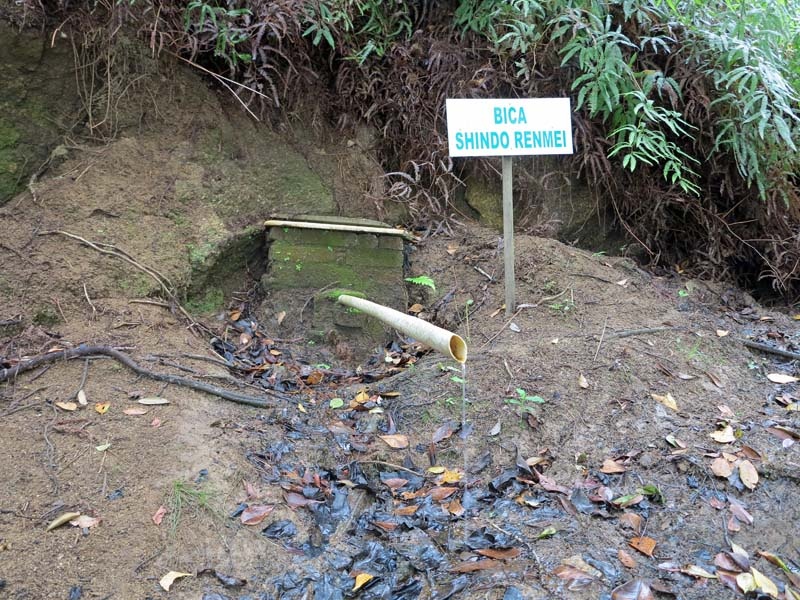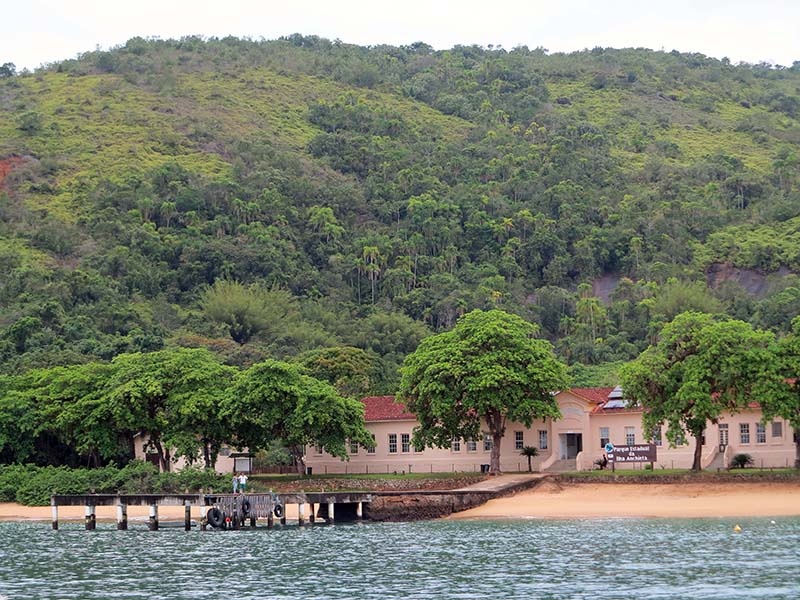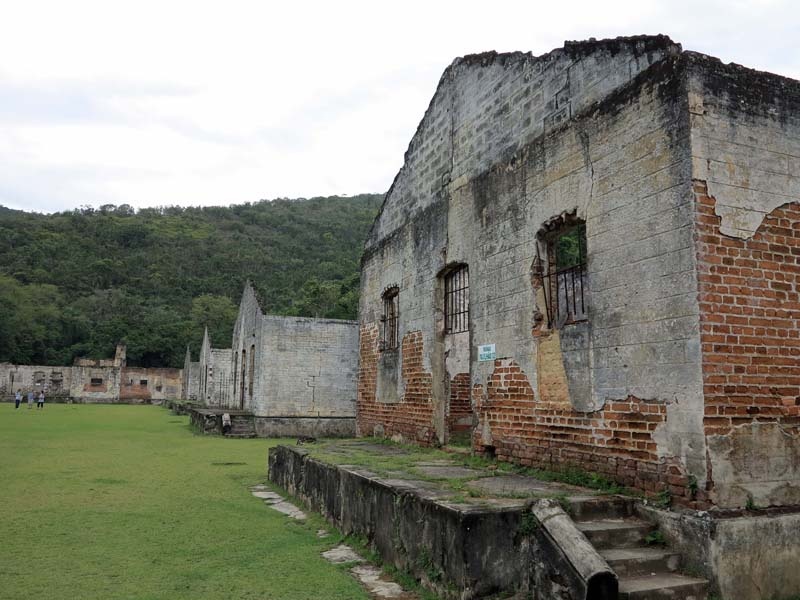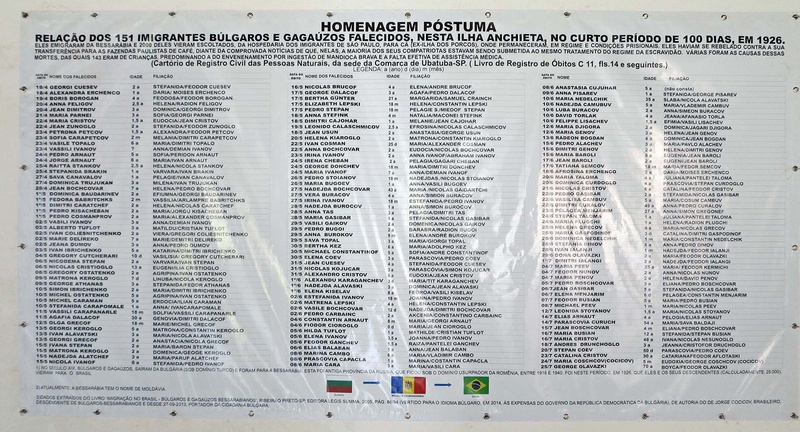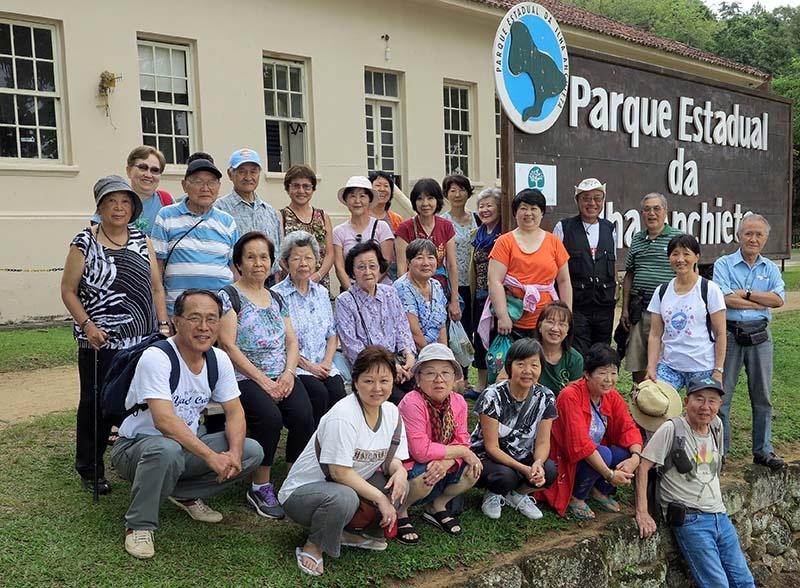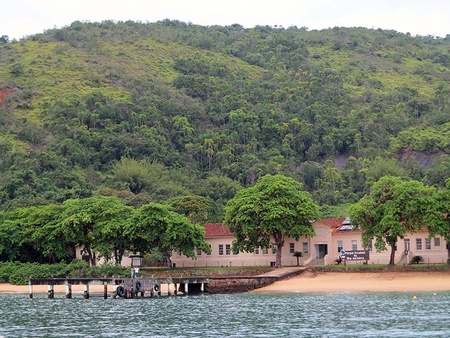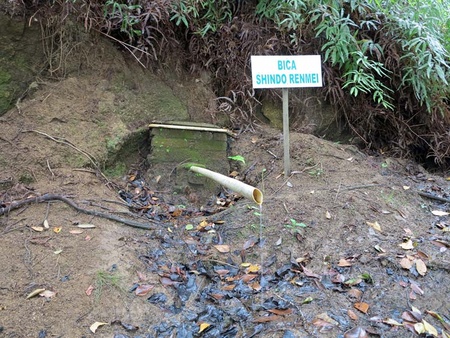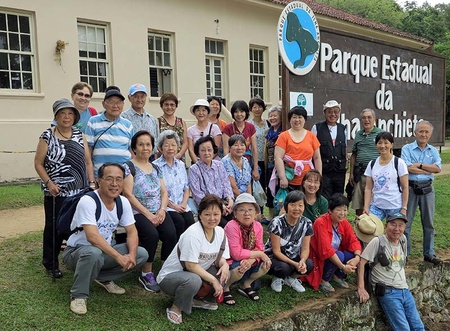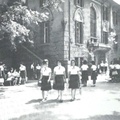A federal prison was built on Alcatraz Island in California, in the United States, which became known as the impossible-to-break “prison island” and was later featured in the movie Escape from Alcatraz (made in 1979 and directed by Don Siegel) starring Clint Eastwood. There is in fact a Brazilian version of the facility on Anchieta Island located on the Northeastern coast of Sao Paulo, which holds the hidden history of 170 imprisoned Japanese immigrants in the immediate aftermath of the war. In commemoration of the Japanese, a water source near the then prison was named “Bica (spout) Shindo Renmei” in the beginning of 2014. Upon hearing the news, I paid a visit to the site with 35 members of the Liberdade Walking Group (with coordinator Tsutomu Ogasawara) on November 22 and 23, 2014.
The Tragedy of Bulgarian Immigrants
151 People Died in 100 Days
The prison was opened in 1908, the same year that the immigration ship Kasato-maru brought the first group of Japanese people to Brazil. From 1926, approximately 2,000 immigrants from Eastern Europe such as Bulgaria and Gagauz landed on the island as colonists. They came to the faraway land in South America in search of peace, after going through the suffering of two Balkan wars and seeing their nations in great ruin.
Prison museum staff member Fabiano Teixeira, however, says that their experience was otherwise. “2,000 people were colonized on this island, including Bulgarian immigrants. With no other food, they ate Mandioca Brava (a poisonous kind of cassava potato) which led many of them to die and the rest of them to leave the place. What a tragedy.” Reportedly 151 people died in just 100 days after their arrival, so without doubt the incident became an unforgettable tragedy in the history of immigration.
According to him, the immigrants did not know how to detoxify cassava. In September, 2014, their descendants visited the prison museum and posted a list of colonists who lost their lives, to pay homage to the hardship of their ancestors.
“It’s sad that there’s no names of Japanese immigrants here,” mumbled one member of the walking group, Harunori Tanaka (age 65, from Hiroshima), while looking at the list.
Indeed, there was no posting of such names, but the island did have one thing that was named after Japanese immigrants—it was “Bica Shindo Renmei.” But what is “Shindo Renmei” anyway?
The-Impossible-to-Break Prison Island
Since President Getúlio Vargas took office in 1930, some of the most vicious criminals and political detainees from across the nation had been sent to the prison on the small island which was deemed impossible to escape alive due to a fast-moving current between the shore and the nearest town Ubatuba.
In fact, 170 Japanese immigrants had been imprisoned there for three years from 1946. Back then, the majority of people in the Nikkei community were a “winning group” (kachigumi) that believed in the victory of Japan and developed conflicts with a “losing group” (makegumi) that accepted the defeat of the country, which later turned into the “winning or losing feud” (kachigumi / makegumi conflict) that even involved murder. Shindo Renmei was the most powerful of the winning group.
About 10 militants including Tokuichi Hidaka who actually committed murder were sent to the island as well. However, the great majority of people were top officials of Shindo Renmei from its headquarters and branches in Sao Paulo who refused to tread on a picture of Japanese Emperor and Empress or a Japanese flag, a practice that was conducted as part of the interrogation of DOPS (Departamento de Ordem Política e Social = Department of Political and Social Order).
Fukuo Ikeda was one of them; just because his brother was a militant, he was taken into custody and was tortured by DOPS and on Anchieta Island which led him to develop mental illness and later commit suicide by taking poison.
The Japanese inmates managed to win some trust of the prison officers and were allowed to celebrate the birthday of the Emperor and hold sports events. In fact, “prison break” was one of the games. (From Nikkei Shimbun, May 14, 2014, “The Tale of Deportation = Detained in Anchieta the Prison Island” Vol. 11, written by Tokuichi Hidaka)
There is also an anecdote about the five-on-five deadly match (the modern-day mixed martial arts match) requested by Brazilian inmates, where it was won by the Japanese team (Hidaka article, Vol. 12) that had some judo experts.
A closed room without any windows known as “Dark Prison” was where the officers confined inmates who rebelled against them. The room was so dark that it made a black person turn purple, as they say (Hidaka article, Vol. 9). In addition, a punishment with a whip made of a bull’s phallus was said to either “make one insane or dead if given more than 10 times.” (Same article, Vol. 9)
Documentary Works and Movies Made One After Another
For a long time, the Nikkei community had sealed off the history of its bloody feud without telling the stories to their descendants. However, in 2000, a famous Brazilian journalist by the name of Fernando Morais published a nonfiction book titled Corações Sujos (Dirty Hearts). The book has been said to dramatize the actual incidents with a farce and thus differ in large part from facts, but it definitely made the Brazilian society take notice of its history.
As a result, the movie Dirty Hearts which was based on Morais’ book (2012, directed by Vicente Amorim) was released in both Japan and Brazil. It’s a rather unusual Brazilian movie with almost all the dialogue spoken in Japanese and cast by famous actors such as Tsuyoshi Ihara, Takako Tokiwa, and Eiji Okuda.
In response to Morais’ book, there has been a backlash from people, including Nikkei descendants who had not heard anything from their parents about the incidents, against the way Shindo Renmei was portrayed like a terrorist group—later Director Jun Mario Okuhara made a documentary film titled Yami no Ichinichi (A Dark Day, 2012, IMJ)
(The film focused on the immigration history before and during the war. Above: The story behind the apology of the “committee of hunting for the truth,” http://www.nikkeyshimbun.jp/2014/140319-71colonia.html)
The Worst Riot in Brazilian History
After the Japanese immigrants were released around 1948, the prison was once again filled with Brazilian vicious criminals and political detainees (especially left-wing activists). Because of the way they were so badly treated, in June, 1952, there was a big riot which resulted in the deaths of 118 people (110 inmates and 8 officers). The incident became a global concern as the worst prison riot in the contemporary history of Brazil. In 1955, the prison came to complete closure.
This incident remained known as the worst bloodshed in prison until another carnage that occurred in October, 1992, during the suppression of a big riot in the Carandiru prison in the city of Sao Paulo, the biggest one in South America (111 inmates died).
Since the riot took place only about four years after the tragedy on the island, we can assume that the majority of prison officers spent time with the Japanese immigrants, too. Even under the same circumstances, as written in the Hidaka articles, the great majority of Japanese immigrants were considered model prisoners.
“This is the first time I see Japanese people visit our place in such a big group,” says Teixeira with surprise, a staff member at the site. Since it’s located near the world-famous tourist destination Rio de Janeiro and just 160 kilometers north of Angra dos Reis where many celebrities own vacation houses, the number of tourists has been increasing for the past few years. Groups of Chileans, the Dutch, and Americans visited the place around the time of the FIFA World Cup Brazil.
Bica Shindo Renmei can be found along the shore, about a five-minute walk on the right side from the prison site. “I don’t know exactly when the place got its name. But I do know that it was named to recognize the experience of Japanese immigrants here,” says Teixeira.
After doing some research, we found out that it was named by the administrative manager of the time Luis Bidetti around March, 2014, as the place earned recognition as the location of the movie A Dark Day. Perhaps it’s the only place in Brazil that was publicly named after Shindo Renmei.
“It’s a very touching film. On the screen you can see the evidence of Japanese immigrants that they indeed made some history here,” recalls Carlos Bacarine (age 32), a security guard who played the role of a character who spreads out a Japanese flag in the last scene of the film.
“I Feel Sad. I Want to Console the Spirits of the Dead.”
Finally the Japanese have come to console the dead. I overheard the voice when we arrived at the boat slip. The history speaks for itself.
“We can see some interesting history here. It must have been more than just a coincidence that the prison was built in the same year that Kasato-maru arrived in Brazil,” says Hisae Yamamuro (Sansei, age 72), one of the members of the walking group whose grandfather came to Brazil on the second immigration ship Ryojyun-maru.
Fujie Takeuchi (age 73, from Fukui) quietly clasped her hands in prayer when she left the island. “I feel that the spirits of the dead are still here. It makes me sad. I wanted to hold a memorial service or a mass to console their spirits.”
Yami no Ichinichi (A Dark Day)—a documentary film that verified the winning or losing feud based on the testimony of Tokuichi Hidaka and others. A bilingual version of the film (with Japanese subtitles added to Portuguese lines) was finally released on YouTube. It’s a must-see movie for anyone interested in the winning or losing feud. (Duration: 1 hour and 22 minutes, directed by Jun Mario Okuhara, 2012)
▼ 14 articles about his experience in Anchieta Island in Nikkei Shimbun contributed by Tokuichi Hidaka, the protagonist of A Dark Day. http://www.nikkeyshimbun.jp/2014/140429-61colonia.html
▼ Approximately 150 primary documents about immigrants in Brazil are available in PDF format for free on the Library of Immigrants in Brazil site.
“Winning Group—the Life of a Detainee in Anchieta Island” (originally titled Gokuchu Kaikoroku (The Prison Memoir)) written by Hekisui Yoshii in 1952 can also be found there. Yoshii was the executive at the Lins branch of Shindo Renmei and wrote his story from a perspective that was different from Hidaka’s. http://www.brasiliminbunko.com.br/
© 2015 Masayuki Fukasawa


